Affiliate disclosure: This post may contain affiliate links. Please see our Privacy Policy.
Growing chocolate trees indoors? Believe it or not, it is possible, even in cold climates!
Vermont’s not exactly known for its tropical weather, but even with our long cold winters, you can still grow and harvest your own chocolate indoors. The cacao trees below were grown from a pod harvested from New Hampshire and germinated in my Vermont home, both zone 4.
The New Hampshire parent tree grown by a friend is about 6 feet tall, and produces a crop of 2 to 5 pods per year, blooming in the summer and ripening mid-winter. That’s not bad when you consider a tree growing outdoors in the tropics produces only 20 pods a year.
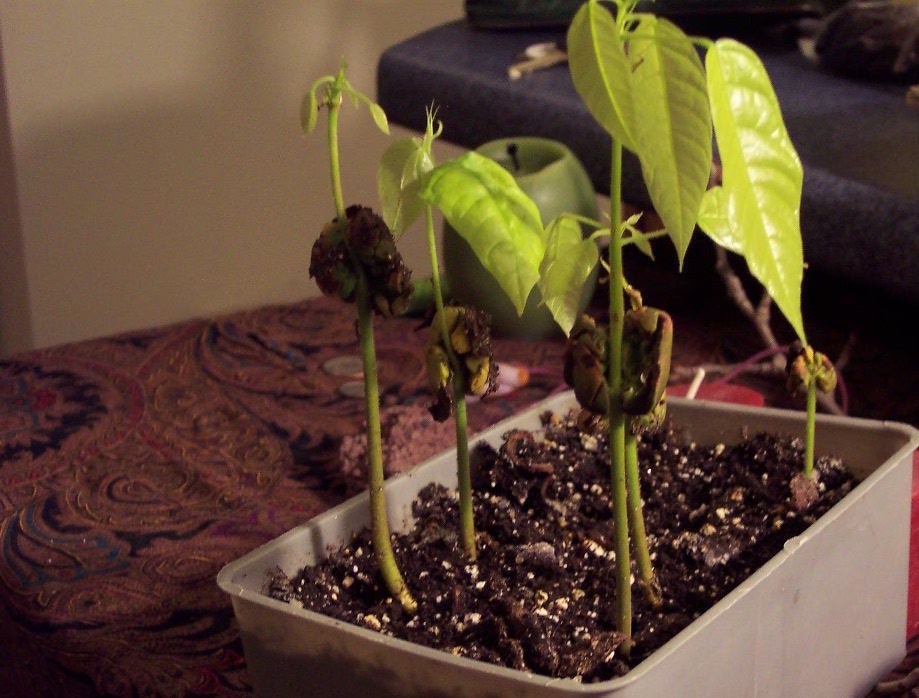
On our homestead, we love the novelty of growing our own tropical edibles. We’ve already had success with homegrown ginger, turmeric, mango trees, coffee, vanilla, lemon trees…why not add chocolate to the mix?
A few years back, I asked my cacao-growing friend to save me a pod. Mid-February, I got a call that my pod was ripe and ready to go. When I arrived, I found that they’d literally written my name on it to prevent anyone else from claiming it.
Since not everyone has a friend that happens to be growing cacao, you can order your own cacao pod online here, and they can be eaten fresh or used for planting.
If you want to skip the germination steps, and get right to growing your own tree indoors, cacao trees are available here.
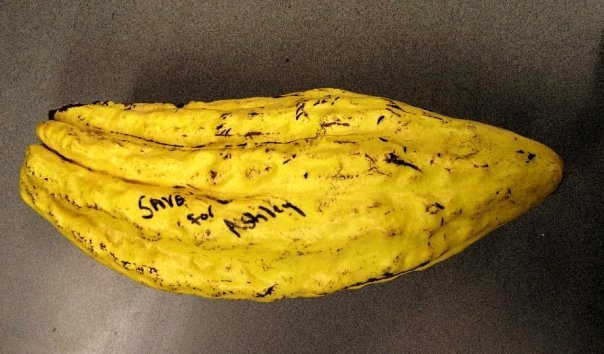
A bit of nomenclature, Theobroma Cacao is the tree name, spelled cacao. The processed chocolate, or cocoa mass, switches the last two letters and adds an o at the beginning. So a cacao tree is needed to grow your own cocoa or chocolate.
It’s important that the seeds are fresh, inside an intact pod. Once the pod is opened they rapidly spoil, and they’ll only germinate while fresh.
Seeds cannot be dried and stored like garden vegetable seed packets. As a tropical plant, in nature, the seeds would be kept warm and moist, and they wouldn’t have the opportunity to dry down like a package of typical garden seeds.
Each cacao bean is coated in a sticky-sweet coating that tempts tropical animals to crack open the tough pods and gorge on the interior nectar. The beans themselves are then discarded as the animal moves throughout the canopy, planting the next generation of cacao trees.
The first step in growing chocolate from seed is to crack open the seed pod, which is roughly 1 centimeter thick. It takes a good butcher knife or chef’s knife and quite a bit of elbow grease, so be careful with your fingers.
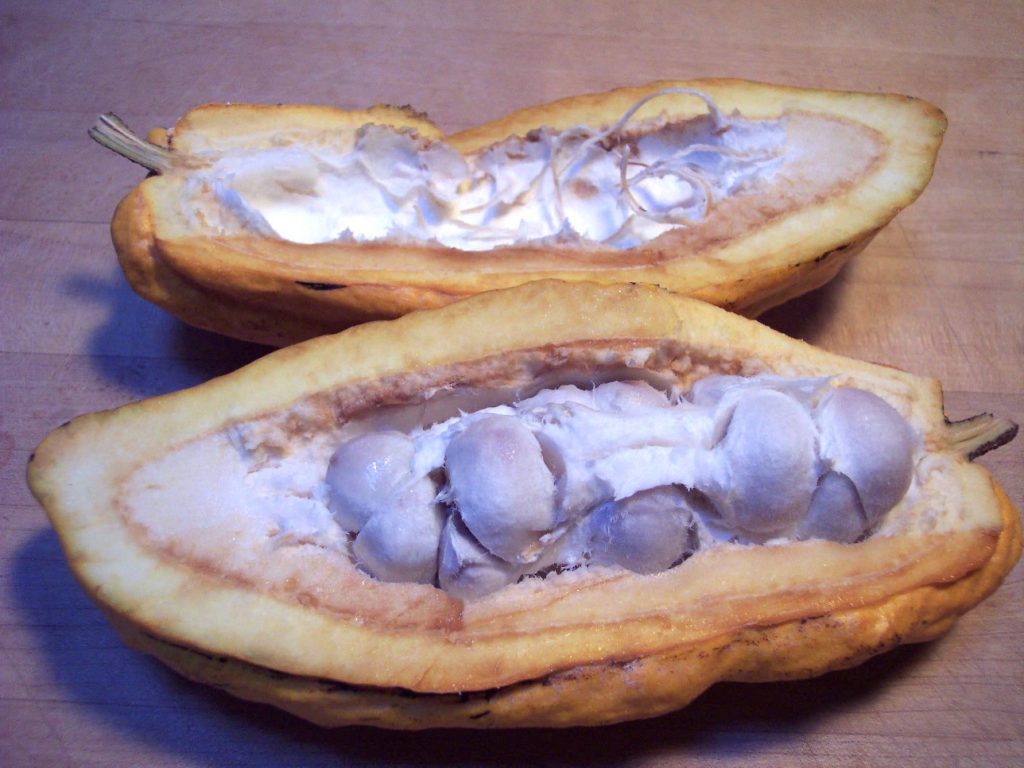
Avoid cutting into the seeds, because they’re surprisingly soft, gummy, and fragile. Even a small nick will inhibit germination, so just very gently hold them in your mouth as the sweet gelatin dissolves around the pods.
In nature, animals eat the white pulp from around the seeds and carefully avoid eating the seeds themselves. You know how chocolate is supposed to be toxic to dogs? Well, those very same seeds aren’t all that tasty to rainforest creatures either, they just eat the sweet pulp and drop the seeds to germinate.
Whole cacao beans or cacao nibs you buy from health food stores have been first fermented to remove the white nectar around the beans, and then dried and roasted to get a hard, crunchy texture.
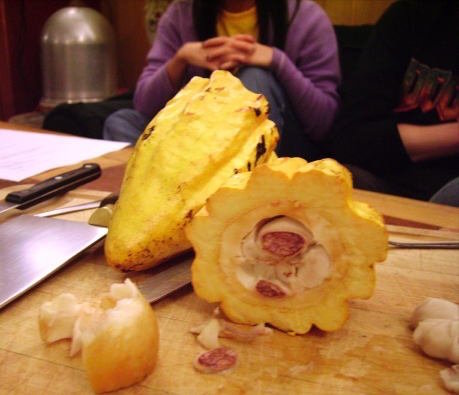
To prepare the seeds, you’ll need a few adventurous friends. I invited over just about everyone I knew when we cut it open because it’s not every day that you get to taste fresh grown raw chocolate.
The most efficient way to clean and prepare the seeds is by placing them into your mouth and sucking off the white cacao nectar. It’s sweet and fruity, and in the group I assembled, every single person loved it.
In the tropics, they ferment it into a liquor, and since the coating spoils so quickly, if you don’t grow your own your only chance to taste it fresh would involve a very expensive plane ride.
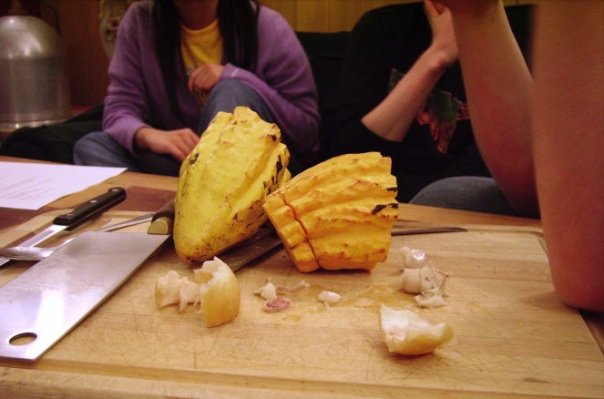
For germination, the seeds want to be kept warm and moist.
My drafty 1850’s schoolhouse in February didn’t seem like it fit the bill, but I created a hot water bottle for them with a Ziploc bag filled with warm water, wrapped in a wet towel. I then placed the freshly cleaned seeds in a wet paper towel, and put that on top of the water-filled bag.
I put the whole setup into my oven with the oven light on for a small amount of extra heat. After just a few days, the seeds had begun to germinate and I transferred them to the soil.
With this method, I had a roughly 50% germination rate. Not bad for a cheap hacked setup.
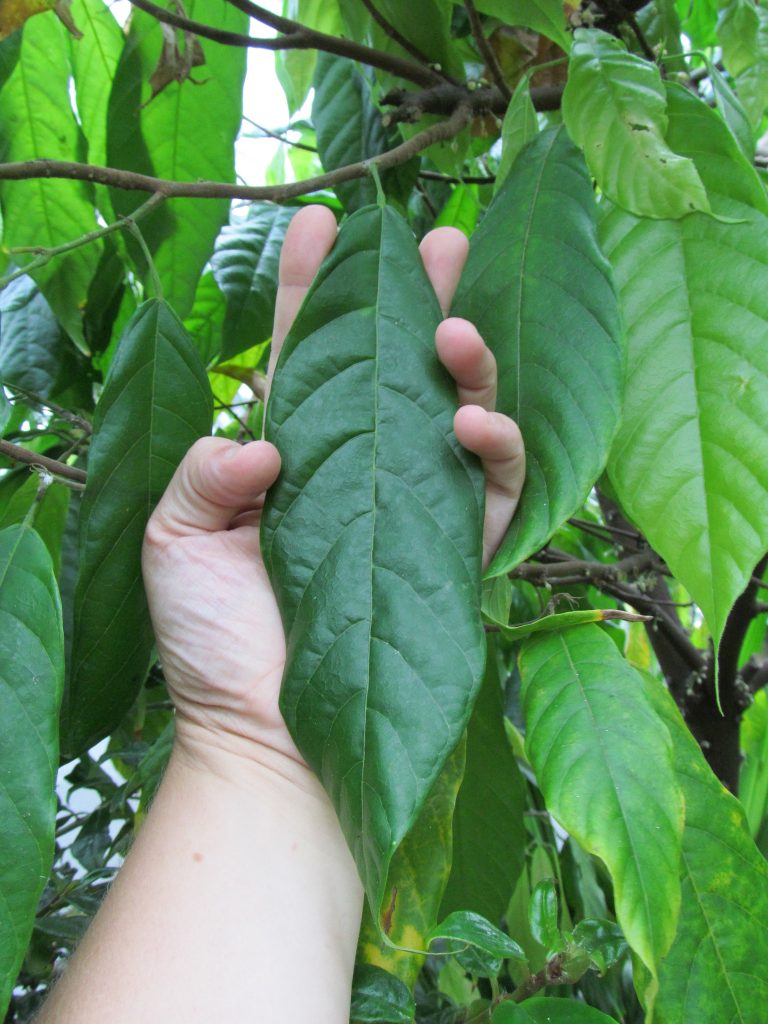
If you’re investing in buying a cacao pod and having it shipped to you, you might as well try a small countertop seed germination setup or at least invest in a seedling heat mat to better ensure success.
Once you’ve got healthy cacao trees, either by germinating your own cacao pods or by starting with a live cacao tree, all you have left to do is wait.

In nature, cacao trees are a zone 10 plant, so they want to be kept warm, but they will grow just fine at room temperature in a normal house. Keeping them consistently between 65 and 70 degrees is sufficient for them to thrive.
They’re an understory plant, so filtered light indoors is actually ideal, and they grow wonderfully even in northern climates near a south-facing window or in a sunroom.
It takes 5-6 years from germination to see your first crop. The flowers will appear directly out of the stem, and though the plant will produce hundreds of tiny flowers, only a few will actually go on to produce cacao pods even in ideal conditions.
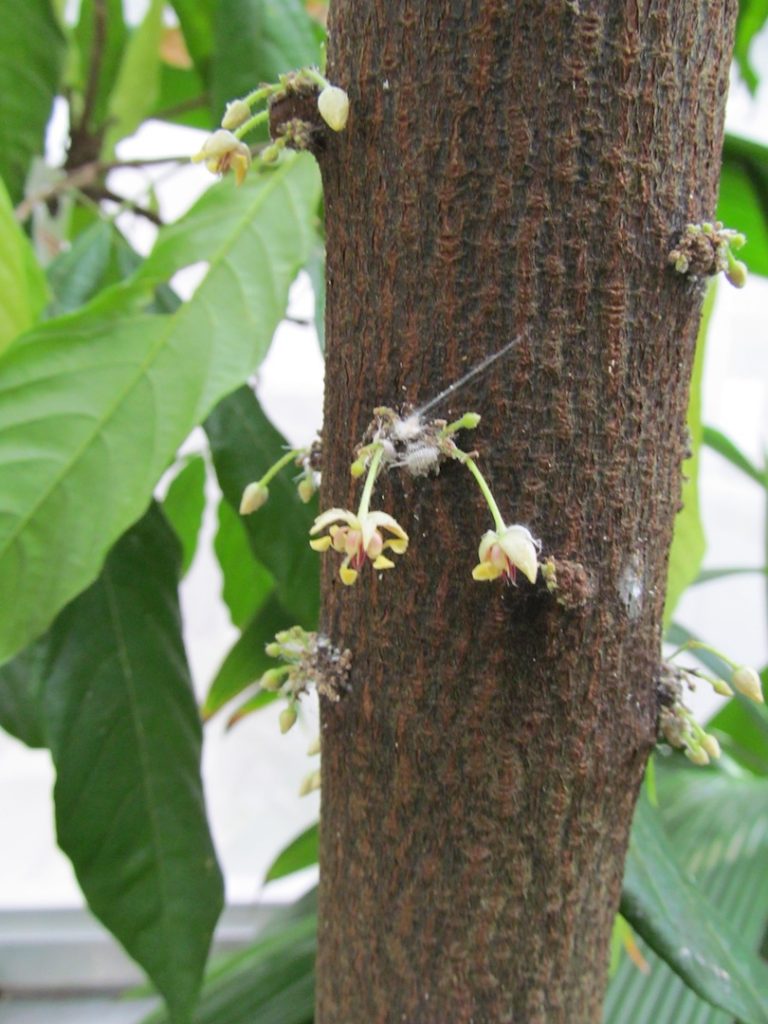
The fruit will begin to form and will grow slowly for 6 to 8 months. Harvest happens in February or March for northern-grown indoor cacao trees.
Be sure to have plenty of friends on hand for the harvest, to share in your success, and help you enjoy the sticky sweet cacao seed coating. When you harvest, you can continue to propagate from the seeds, or you can try eating the fresh raw seeds themselves.
They have a unique flavor, and texture, somewhat like a very firm grape or kiwi.
It really is a rare treat to get to enjoy your own fresh, raw chocolate from a homegrown tree.
Making your own chocolate from raw cacao pods is a bit involved, but it’s well worth the effort. Here are my instructions for making chocolate from scratch.
Best of luck, and get growing!
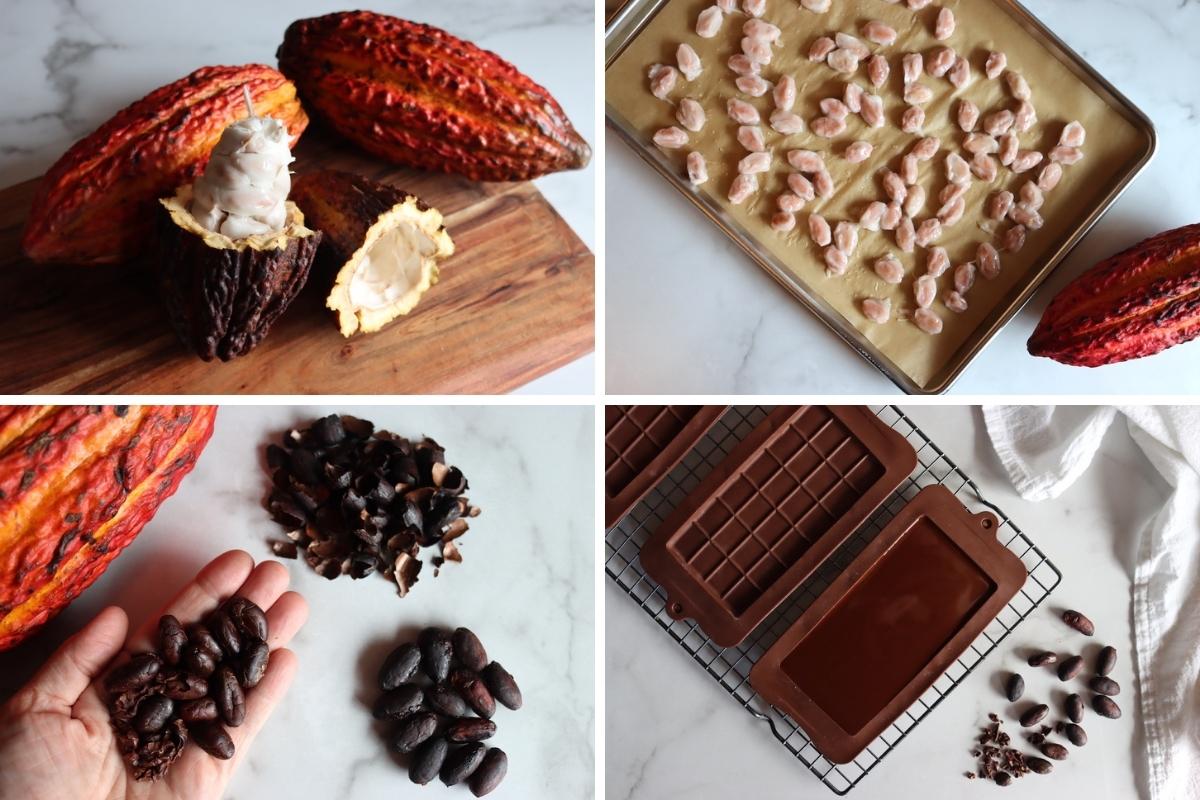
Plant Growing Guides
Looking for more unusual plants you can grow at home?
- How to Grow Shipova
- How to Grow Cranberries
- How to Grow Pineberries
- How to Grow Salmonberries
- How to Grow Nanking Cherries
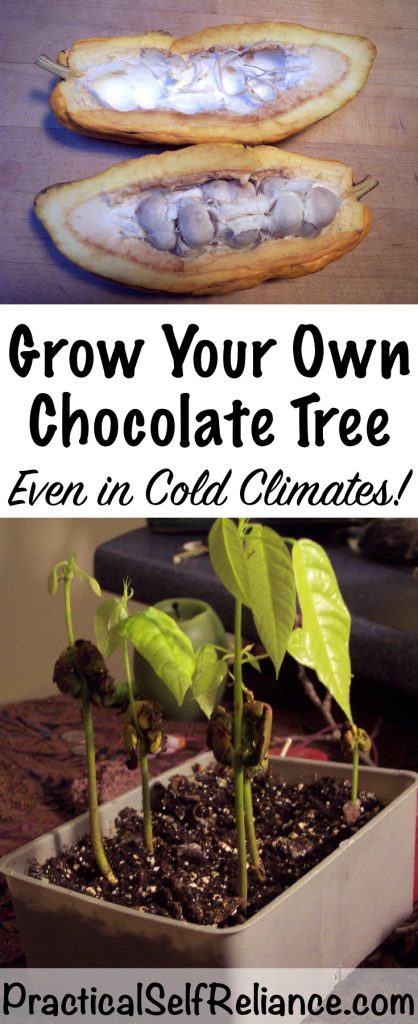
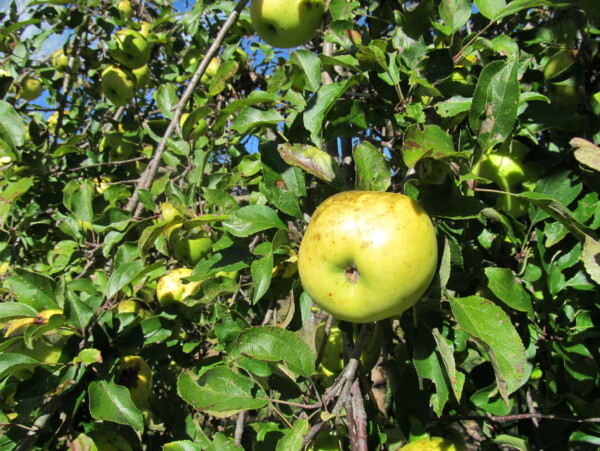













Great article. Do you grow your cacao tree in a greenhouse and transfer somewhere warm during the winter?
I just kept mine in front of a big window in the winter.
Hello Ashley,
Thanks for all you great articles.
Where can I buy chocolate seed to plant and start a tree.
Thank you very much,
Paolo
They have to be freshly harvested from inside the pod to germinate, so you’ll need to buy a whole pod and then extract the seeds. Tropical Fruit Box is the only place I know where you can buy the pods. Best of luck!
Thank you very much Ashley,
Have a nice Sunday.
I got my latest pods from Montoso Gardens in Puerto Rico – https://www.montosogardens.com/online_store/ – they can ship to the mainland. I have Amenolado (a Forastero) specifically for rootstock to graft other varieties onto, and a pair of happy Criollo varieties, all growing happily and vigorously in hydroponics under lights in my growroom.
Hey!
I am in North East MA. I have a 10×8 greenhouse sitting in the basement. How crazy am I to want to get into a tropical plant? Your article is inspiring, but I’m new to this!
-Josh
I don’t think it’s crazy at all.
How much cocoa powder does 2-5 pods per year produce?
I’m not sure exactly how much powder would come from 2-5 pods per year. Each pod contains about 40 beans and it takes about 500 beans to make a pound of chocolate. One tree produces about 30 pods, so a single tree will give you about 2 pounds of chocolate.
Thanks, Ashley, for writing about this! Super informative and interesting. I have learned a lot reading it and might try a tree myself 🙂
You’re very welcome. So glad you enjoyed the post. Let us know if you decide to get a tree of your own.
I’m going to grow my first cacao tree. I live in Northeastern Washington state, zone 5b. We’re experiencing unusually high temps right now, between 105-112°, with night lows around 70°. Humidity is in the 40s to low 50s. I’ve read some of the posts here which have been very informative.
Can someone please give me some advice on how I should proceed? Should I order my plant now or wait until the temps are closer to our norm in the 90s? Is there a book or other resources I can order to learn more before I even order the plant?
I know the cacao tree is a tropical plant and that where I live isn’t ideal for this plant, but if someone living in Vermont can successfully grow one, so can I! I’ve already figured out that I’ll have to grow this indoors in a container and provide it with humidity, especially in winter when the woodstove is going all day and night. As a caveat, can it be kept outdoors during these warm days if it’s provided with the necessary humidity and sunlight? Also, would woodland critters such as deer, squirrels, raccoons, birds, elk, moose, bears, chipmunks….be tempted to nibble on it?
Sunlight is scarce here come winter because we usually have lots of cloud cover much of the time. Are grow lights revommended?
Please assist….as a self-diagnosed “chocoholic”, this would be my greatest achievement off I could successfully grow and then harvest my own cacao beans (even if I have to wait 5-6 years to do so!).
They are actually an understory plant so filtered indoor light is ideal, but you might need to supplement a bit with a grow light if you don’t get a lot of indoor light. I don’t see any reason why you couldn’t go ahead and order your plant. I was able to find this book on Amazon by Byron E. Martin and Laurelynn G. Martin Growing Tasty Tropical Plants in Any Home, Anywhere: (like lemons, limes, citrons, grapefruit, kumquats, sunquats, tahitian oranges, barbados … black pepper, cinnamon, vanilla, and more…) I haven’t read it, but it looks like it has some good reviews. I don’t see any reason why it couldn’t be kept outdoors. I move many of my tropical plants outdoors in the summertime. It is certainly possible that the wild critters may want to nibble it though so just be aware of that possibility.
Thank you for your reply! I can’t wait to get started!
You’re welcome.
Thank you! I think this might be the best response yet, and I have already ordered the E book. I just got some coffee plants, i am awaiting my cacao, and i previously started a tangerine from seed. I also am actively working on growing a number of tropical trees (hopefully for bonsai) and can definitely benefit from a good guide book on growing tropical trees… in Brooklyn (no lie).
You’re very welcome.
My cacao trees grow indoors, in an east-facing bay window. That will change as I upgrade my growing environment and get them nearly totally on LED lighting. I am in the process of air-layering the tallest trees that have reached above my window, with the intent of planting those air-layers into hydroponic dutch buckets. The parents of those air-layers will follow suit pending the efficacy of the dutch-bucket system. All grown indoors where I can more closely control the environment.
I recommend LED grow-lights – especially in the winter months with our short days. That will keep your tropicals growing over the winter. Otherwise, they’ll sulk and not grow much if at all for months of the year. I have mine on a timer with 16 hours on, 8 hours off.
That’s awesome. How did your air layering experiment go? Curious to hear about it, since I’m also planning to grow cacao trees, but to propagate them from air layers would be better on the long term, to get big trees faster.
PS I’m dutch and had to Google what a dutch bucket was, never heard about it!